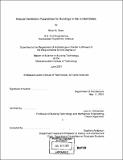| dc.contributor.advisor | Leon R. Glicksman. | en_US |
| dc.contributor.author | Dean, Brian N. (Brian Nathan), 1974- | en_US |
| dc.contributor.other | Massachusetts Institute of Technology. Dept. of Architecture. | en_US |
| dc.date.accessioned | 2011-09-13T17:43:29Z | |
| dc.date.available | 2011-09-13T17:43:29Z | |
| dc.date.issued | 2001 | en_US |
| dc.identifier.uri | http://hdl.handle.net/1721.1/65726 | |
| dc.description | Thesis (S.M.)--Massachusetts Institute of Technology, Dept. of Architecture, 2001. | en_US |
| dc.description | "June 2001." | en_US |
| dc.description | Includes bibliographical references (p. 171-172). | en_US |
| dc.description.abstract | In the United States, many of the commercial buildings built in the last few decades are completely mechanically air conditioned, without the capability to use natural ventilation. This habit has occurred in building designs since the designers do not have the tools to understand the impact of using natural ventilation as an option in conditioning a building. Research has been conducted to create a better understanding of how natural ventilation can be used successfully in building designs. First, understanding the buildings that currently use natural ventilation and secondly by analyzing how buildings can operate in different climates. It is important in the building design industry to know the feasibility of designs, and is therefore important to see buildings that have used natural ventilation techniques. It is also important in the building design industry to know if the natural ventilation techniques that have been used, can be used in the climate that a building needs to be designed for. It was determined that increased airflow through natural means can significantly enhance the functionality of buildings in the United States. Throughout the United States there are numerous hours when outdoor conditions suggest using natural ventilation for a primary cooling system. Natural ventilation can help a building maintain comfort for the occupants, reduce energy usage, reduce cooling equipment size and increase indoor air quality. With the use of a natural ventilation design tool, designers can understand the impact that each of the buildings major features has on the overall comfort or energy required to make it comfortable. | en_US |
| dc.description.statementofresponsibility | by Brian N. Dean. | en_US |
| dc.format.extent | 172 p. | en_US |
| dc.language.iso | eng | en_US |
| dc.publisher | Massachusetts Institute of Technology | en_US |
| dc.rights | M.I.T. theses are protected by
copyright. They may be viewed from this source for any purpose, but
reproduction or distribution in any format is prohibited without written
permission. See provided URL for inquiries about permission. | en_US |
| dc.rights.uri | http://dspace.mit.edu/handle/1721.1/7582 | en_US |
| dc.subject | Architecture. | en_US |
| dc.title | Natural ventilation possibilities for buildings in the United States | en_US |
| dc.type | Thesis | en_US |
| dc.description.degree | S.M. | en_US |
| dc.contributor.department | Massachusetts Institute of Technology. Department of Architecture | |
| dc.identifier.oclc | 49555802 | en_US |
